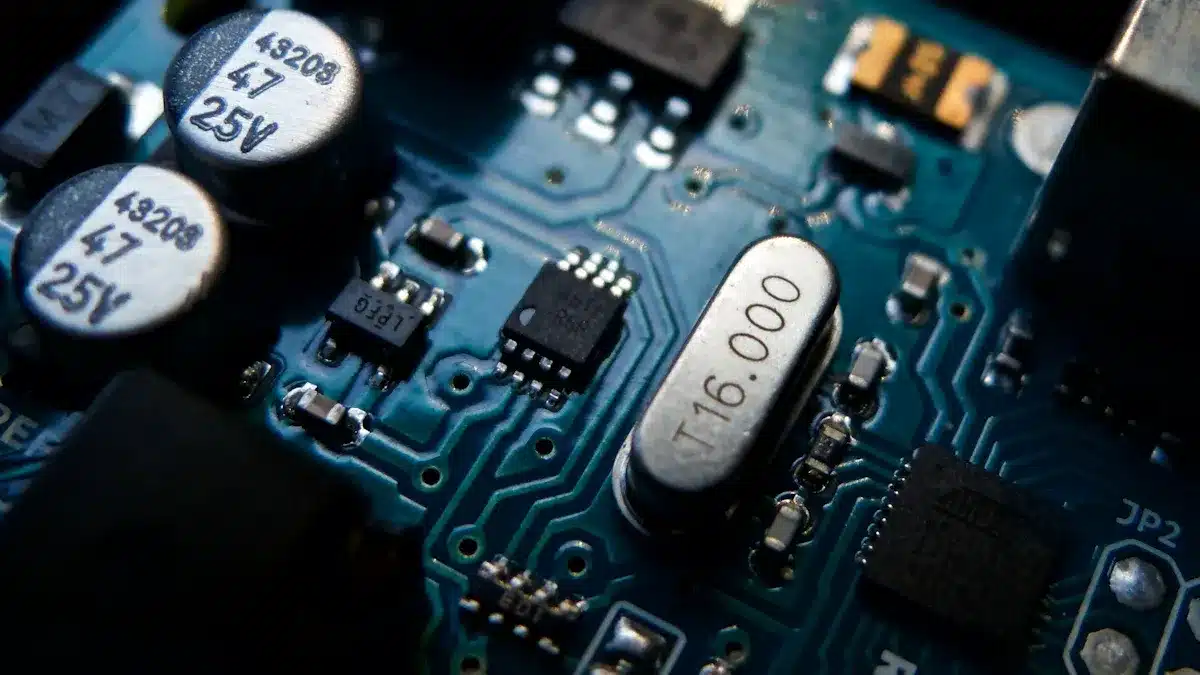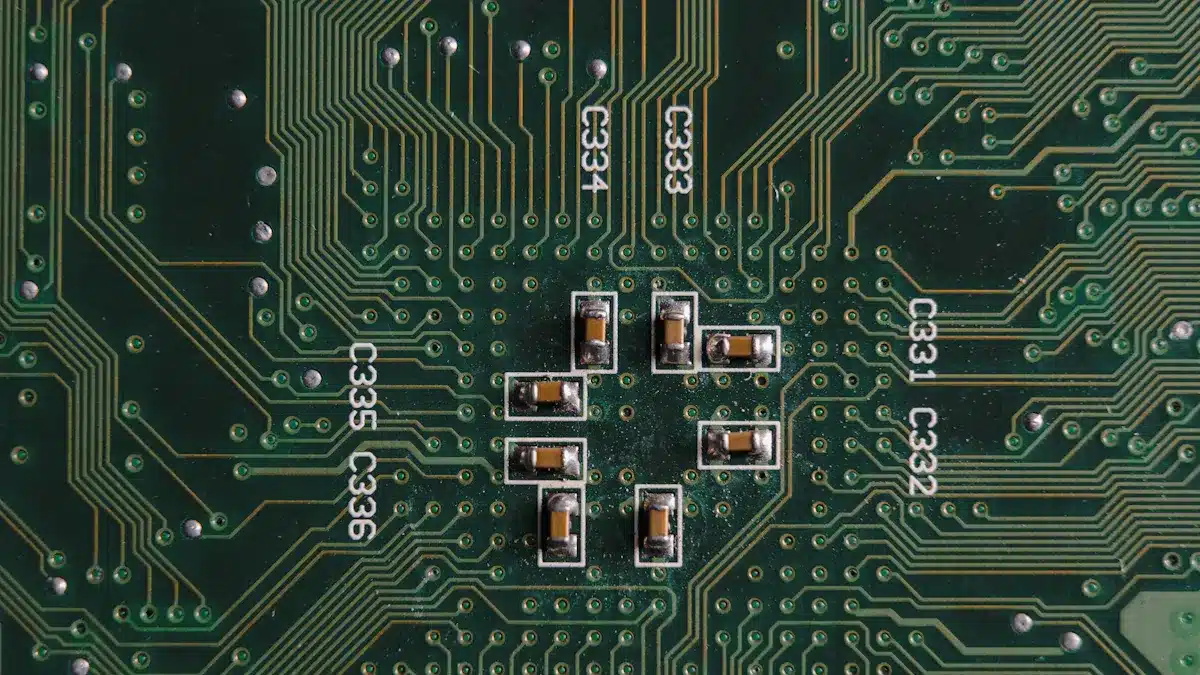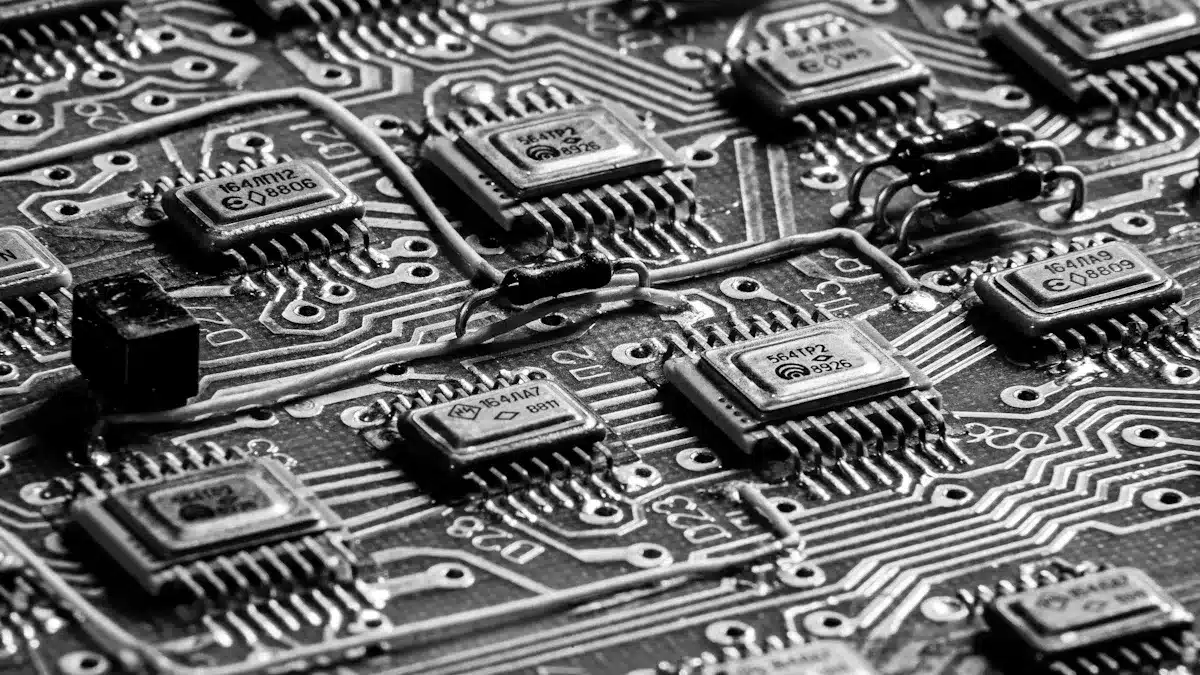
Protecting electronic circuits from sudden voltage spikes is important. You need the right tool to keep your parts safe. A diode transil provides strong protection by stopping high-energy surges. This makes it great for handling large energy bursts. Knowing your needs, like voltage and speed, helps you pick the best option for safety.
Key Takeaways
Transil diodes stop big voltage surges. They work well in heavy-duty machines and cars.
ESD diodes block small voltage spikes from static electricity. They are great for phones and laptops.
Think about the environment and voltage dangers when picking diodes. This keeps your devices safe and working.
Transil diodes act faster during strong energy events. ESD diodes are fast enough for everyday electronics.
Balancing price and performance is important. Use strong diodes for important systems and cheaper ones for simple devices.
Understanding Transil Diodes

What is a Diode Transil?
A diode transil is a special type of TVS diode. It protects electronics from sudden voltage spikes during transient events. These events include lightning, power surges, or static electricity. Normally, the diode stays “OFF” and uses very little power. When a voltage spike happens, it turns “ON.” This action stops the extra voltage and absorbs the energy. It keeps sensitive parts safe from harm.
Tip: Think of a diode transil as a guard. It steps in only when your system faces a voltage threat.
Key Features and Benefits of Transil Diodes
Transil diodes have important features that make them great for protection:
Fast Response Time: They act quickly to stop voltage spikes.
High Energy Absorption: They handle large energy amounts, perfect for high-power uses.
Reliability: They improve the lifespan and dependability of electronics.
Low Leakage Current: They use very little power when not active, saving energy.
These features make transil diodes a trusted choice for protecting electronics from voltage problems.
Applications of Transil Diodes
Transil diodes are used in many areas where protection is needed:
Consumer Electronics: They protect phones, laptops, and gaming devices from power surges.
Industrial Equipment: They shield factory machines and systems from voltage spikes.
Automotive Systems: They keep car electronics like sensors and navigation systems safe.
Medical Devices: They help medical tools like monitors and imaging systems work reliably.
In real life, transil diodes are very useful. For example, in medical treatments, they ensure accurate dose delivery. They also improve the safety of heart devices by checking doses near treatment areas. These examples show how important they are in both everyday and special uses.
Exploring ESD Diodes
What are ESD Diodes?
An ESD diode is a small device that protects electronics. It stops sudden voltage spikes caused by static electricity. It works by blocking extra voltage and sending it to the ground. This keeps delicate parts, like chips, from getting damaged. You often see ESD diodes in gadgets with USB or HDMI ports. They react quickly and don’t mess up signals, making them great for fast connections.
Note: Think of ESD diodes as shields. They guard your devices from static electricity.
Key Features and Benefits of ESD Diodes
ESD diodes have features that make them great for protection:
Quick Response Time: They stop voltage spikes in a flash.
Low Capacitance: They don’t interfere with fast signals.
Compact Size: Their small size fits tiny gadgets easily.
Reliable Protection: They keep your devices working longer.
Here’s a table comparing ESD diodes and TVS diodes to show their differences:
Parameters | ESD Diode | TVS Diode |
|---|---|---|
Purpose | Stops static electricity damage. | Blocks big voltage surges. |
Response Time | Reacts in nanoseconds. | Works for longer voltage events. |
Clamping Voltage | Lower for small shocks. | Higher for bigger surges. |
Energy Handling | Handles less energy. | Absorbs more energy. |
Applications | Best for static-prone gadgets. | Great for power lines. |
Applications of ESD Diodes
You’ll find ESD diodes in many places where static can harm devices:
Consumer Electronics: Protects phones, tablets, and laptops from static shocks.
High-Speed Interfaces: Guards USB and HDMI ports without ruining signals.
Automotive Systems: Keeps car sensors and screens safe from static.
Wearable Devices: Protects smartwatches and fitness trackers from damage.
Picking the right ESD diode helps your gadgets stay safe and work well in static-heavy areas.
Comparing Transil Diodes and ESD Diodes

Voltage Handling and Energy Absorption
Transil diodes are great at handling high-energy voltage spikes. They can absorb large energy amounts, protecting electronics from big surges. For example, they work well against lightning strikes or power line issues. This keeps your sensitive devices safe during tough conditions.
ESD diodes, however, handle smaller voltage spikes caused by static electricity. They can’t absorb as much energy as Transil diodes. But they are perfect for protecting gadgets like phones and laptops. These devices often face static discharge problems.
Tip: Use Transil diodes for big surges. Choose ESD diodes for small, frequent spikes.
Response Time and Speed
A diode’s response time shows how fast it reacts to voltage spikes. Transil diodes are super quick, reacting in picoseconds. This makes them great for protecting fast systems like communication devices. They also handle longer-lasting surges, from microseconds to milliseconds.
ESD diodes are also fast, with response times in nanoseconds. They are ideal for gadgets with high-speed ports like USB or HDMI. While not as fast as Transil diodes, they work well for smaller voltage spikes.
Here’s a table comparing their response times:
Parameters | ESD Diode | TVS Diode |
|---|---|---|
Response time | Fast reaction in nanoseconds | Ultra-fast for high-energy surges (picoseconds to milliseconds) |
Note: For very fast systems, Transil diodes are better. For everyday gadgets, ESD diodes are fast enough.
Physical Size and Cost
Size and cost matter when picking between these diodes. ESD diodes are tiny and fit well in small devices. Their small size is perfect for modern gadgets with limited space. They are also cheaper, making them popular in consumer electronics.
Transil diodes are a bit bigger because they handle more energy. This makes them less ideal for tight spaces. They also cost more due to their strong design and ability to handle tough conditions.
If you need something small and affordable, go with ESD diodes. But if you need strong protection, the size and cost of Transil diodes are worth it.
Suitability for Different Applications
Choosing between Transil diodes and ESD diodes depends on your needs. Each type works best in certain situations based on the kind of voltage spikes and protection required.
High-Power Applications
For high-energy environments, Transil diodes are the best option. They handle big voltage surges like lightning strikes or power issues. Industrial machines and power systems often face strong voltage events. Transil diodes protect sensitive parts in these cases, keeping them safe.
Consumer Electronics
Everyday gadgets like phones and laptops need ESD diodes. These devices often face static electricity during use or charging. ESD diodes guard delicate circuits from small, frequent voltage spikes. Their tiny size and low cost make them perfect for gadgets with limited space.
Automotive Systems
Cars use both Transil diodes and ESD diodes for safety. Transil diodes stop big voltage surges from the car’s electrical system. ESD diodes protect sensors and screens from static electricity. Using both types ensures full protection for modern vehicles.
High-Speed Interfaces
Devices with fast data ports like USB or HDMI need ESD diodes. These diodes don’t mess up signals, keeping data fast and clear. If your device has high-speed communication, ESD diodes provide protection without slowing it down.
Medical Equipment
Medical tools need to work reliably. Transil diodes protect big machines like monitors from power surges. Smaller devices, like portable medical tools, use ESD diodes to stop static damage during handling.
Tip: Think about the risks your device faces. This helps you pick the right diode for better protection.
Knowing what each diode does helps you choose wisely. This improves how long and how well your electronics work.
Choosing the Right TVS Diodes for Your Needs
Evaluating Application Requirements
Picking TVS diodes means knowing what your device needs. Different gadgets face problems like voltage spikes or static shocks. You must check voltage levels, energy handling, and speed to match your needs.
For example, phones and tablets use TVS diodes to stop overvoltage. Electric cars use many diodes to protect batteries and parts. In 5G networks, TVS diodes help handle voltage changes without slowing data.
Here’s how TVS diodes are used in different industries:
Application Area | Market Size (Units) | Key Insights |
|---|---|---|
Consumer Electronics | 1.3 billion | Phones and tablets need TVS diodes for overvoltage safety. |
Automotive Electronics | 600 million | EVs use 45-60 TVS diodes for battery and surge protection. |
Telecommunications | 700 million | 5G stations use 15-20 TVS diodes to handle voltage safely. |
Industrial Applications | 500 million | Automation tools use TVS diodes to stop surge damage. |
Military / Aerospace | 80 million | Radar and avionics need TVS diodes that meet strict standards. |
Computing | 540 million | Fast data systems use low-capacitance TVS diodes to keep signals clear. |
Others | 180 million | Medical tools and smart cities need precise TVS diodes for safety. |

Looking at these numbers helps you pick the right TVS diodes. Whether for fast data or factory machines, matching the diode to your system keeps it safe.
Environmental and Industry Considerations
Where your device works affects your TVS diode choice. Gadgets in tough places, like hot or wet areas, need strong diodes. Cars face changing temperatures, so durable diodes are key. Factory machines deal with electrical noise, needing diodes that absorb lots of energy.
Rules also matter. Military tools need TVS diodes that follow strict standards. 5G networks need diodes that protect without slowing data. Picking the right diode can make your device last longer. This saves money and keeps it working well.
Tip: Check the environment and rules before choosing. This ensures your diodes work as needed.
Balancing Cost and Performance
Cost and quality are important when picking TVS diodes. Better diodes cost more but protect better. Transil diodes are pricey but handle big voltage surges. ESD diodes are cheaper and good for small gadgets.
Think about your needs. For phones, affordable ESD diodes work well. For cars or factories, spend more on strong diodes for safety.
Here are tips to balance cost and quality:
Know the Risk: Check how often voltage spikes happen in your system.
Protect Key Parts: Use strong diodes for sensitive areas like sensors.
Plan for the Future: Spending more now can save repair costs later.
By thinking carefully, you can pick TVS diodes that fit your needs and budget.
Picking between Transil diodes and ESD diodes depends on your device’s needs. Transil diodes manage big energy surges, perfect for factories and cars. ESD diodes stop static shocks, great for small and affordable gadgets.
Key Insight: Transil diodes handle strong energy bursts. ESD diodes protect fragile parts from tiny, frequent shocks.
Think about your device’s environment, voltage risks, and budget. Choosing the right diode keeps your electronics safe and lasting longer. Take time to understand your needs and decide wisely.
FAQ
1. What’s the key difference between Transil and ESD diodes?
Transil diodes stop big surges like lightning. ESD diodes block small static shocks. Use Transil diodes for machines and ESD diodes for gadgets.
Tip: Pick the right diode for your device’s voltage risks.
2. Can one device use both types of diodes?
Yes, it’s possible. Transil diodes handle power surges, while ESD diodes stop static shocks. Using both gives full protection for sensitive electronics.
3. How can I choose the right diode for my device?
Check your device’s voltage, energy needs, and size limits. For high-power systems, go with Transil diodes. For small gadgets, pick ESD diodes.
Note: Think about your environment and rules before choosing.
4. Are ESD diodes cheaper than Transil diodes?
Yes, ESD diodes cost less. They’re great for small devices on a budget. Transil diodes cost more because they handle bigger energy surges.
5. Do TVS diodes affect signals in fast devices?
ESD diodes don’t mess up signals in USB or HDMI ports. Transil diodes might slightly affect signals in fast systems. Choose based on your device’s needs.
Emoji Insight: ⚡ ESD diodes = Signal-safe. Transil diodes = Surge-strong.
See Also
Finding the Ideal RF PCBA Company for Your Requirements
Selecting the Right PCB Fabrication Manufacturer for You
Choosing the Top PCB Prototype Manufacturer for Your Project